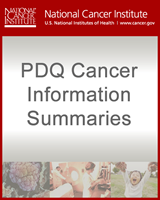From: Unusual Cancers of Childhood Treatment (PDQ®)

PDQ Cancer Information Summaries [Internet].
Bethesda (MD): National Cancer Institute (US); 2002-.
NCBI Bookshelf. A service of the National Library of Medicine, National Institutes of Health.
| Germline Mutation | Syndrome | Proportion of all PGL/PCC (%) | Mean Age at Presentation (y) | Penetrance of PGL/PCC (%) |
|---|---|---|---|---|
| RET | MEN2 | 5.3 | 35.6 | 50 |
| VHL | VHL | 9.0 | 28.6 | 10–26 |
| NF1 | NF1 | 2.9 | 41.6 | 0.1–5.7 |
| SDHD | PGL1 | 7.1 | 35.0 | 86 |
| SDHFA2 | PGL2 | <1 | 32.2 | 100 |
| SDHC | PGL3 | <1 | 42.7 | Unknown |
| SDHB | PGL4 | 5.5 | 32.7 | 77 |
| SDHA | - | <3 | 40.0 | Unknown |
| KIF1B-beta | - | <1 | 46.0 | Unknown |
| EGLN1 | - | <1 | 43.0 | Unknown |
| TMEM127 | - | <2 | 42.8 | Unknown |
| MAX [50] | - | <2 | 34 | Unknown |
| Unknown | Carney triad | <1 | 27.5 | - |
| SDHB, C, D | Carney-Stratakis | <1 | 33 | Unknown |
| MEN1 | MEN1 | <1 | 30.5 | Unknown |
| No mutation | Sporadic disease | 70 | 48.3 | - |
MEN1 = multiple endocrine neoplasia type 1; MEN2 = multiple endocrine neoplasia type 2; NF1 = neurofibromatosis type 1; VHL = von Hippel-Lindau.
aAdapted from Welander et al.[47]
From: Unusual Cancers of Childhood Treatment (PDQ®)

NCBI Bookshelf. A service of the National Library of Medicine, National Institutes of Health.